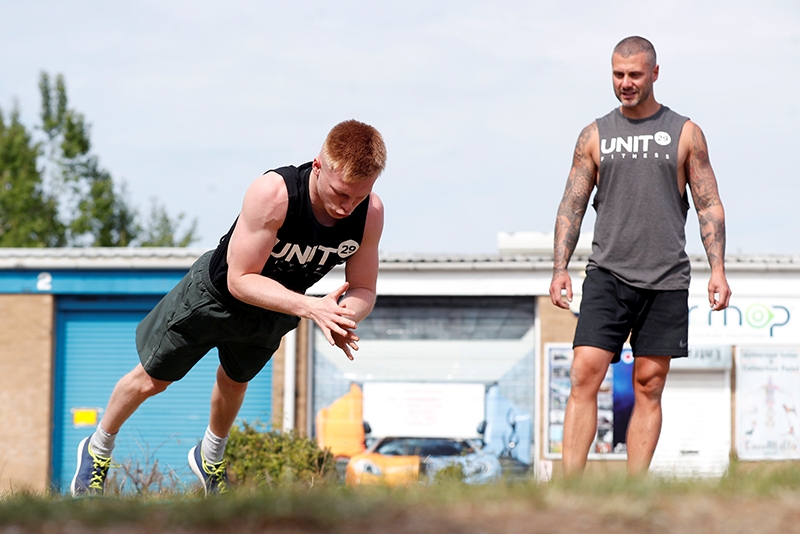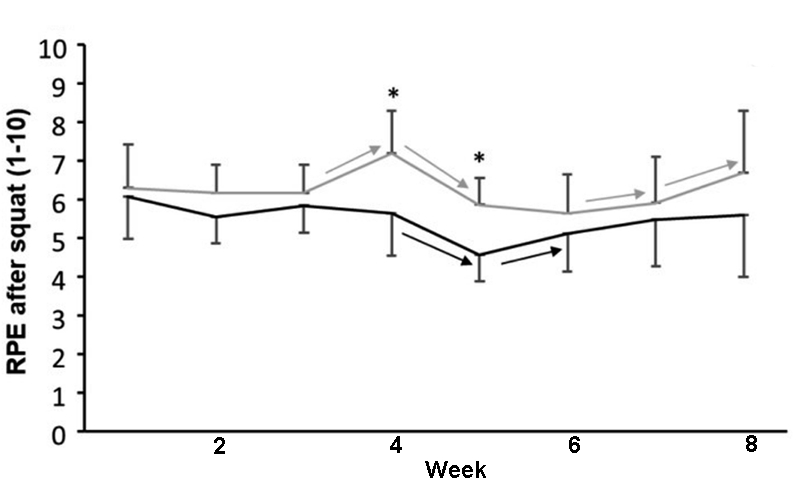You are viewing 1 of your 1 free articles. For unlimited access take a risk-free trial
Strength training: is less but more often better for athletes?

Sports Performance Bulletin looks at new research on how the volume and frequency of strength training can be manipulated for superior results
Over the past couple of decades, a very large body of research has accumulated showing the benefits of strength training for a wide range of athletes. One of the most obvious is that the increased resilience of stronger muscles can help reduce the risk of injury – both those arising from inherent weaknesses and those of strength imbalances between different muscle groups. Another obvious benefit is for athletes whose sports require strength and power, or those engaging in sports, which although primarily endurance in nature, require occasional bursts of power – for example, a sprint for the finish line or a mid-race burst to break away from the pack.But strength training doesn’t just benefit strength and power; more recent studies have demonstrated that strength training can significantly boost muscle efficiency – more technically known as ‘muscle economy’ (see figure 1 and also this article for a more in-depth article on economy and how to improve it)(1-5). Improved muscle economy is a vital component of endurance performance, allowing athletes to perform at a sub-maximal pace for less oxygen and energy cost, therefore reducing accumulated fatigue and boosting performance in long-distance events.
Figure 1: Examples of study findings on strength training and muscle economy(1-5)

Getting maximum bang for buck
There’s no doubting the benefits of adding strength training to a program for athletes. However, there’s a trade off at play; performing high-quality strength sessions requires mental and physical energy. But so does the sport-specific training sessions, and there’s only so much energy an athlete has before risking excessive fatigue that could impact on his/her sport performance or (in the longer-term) risk overtraining. The key therefore is to make any strength training performed as productive as possible so strength gains can be had while minimizing demands on the athlete’s physical reserves – ie it should produce the biggest bang per unit of time and effort invested.In a recent article on how strength training right through the season could produce additional benefits for sportsmen and women, we touched on the types of strength training programs that are likely to produce the maximum gains per unit of time invested. In other articles looking into maximizing strength gains, we’ve also considered aspects such as optimizing the order of strength exercises, whether or not to work to failure, the value of eccentric contractions and how many sets per week works best. One aspect that’s been poorly understood however is the optimum strength training frequency for maximizing strength gains per unit of time. Should athletes perform their weekly strength training workload in one or two big chunks, or instead distribute it into smaller chunks performed more frequently across the week?
Two or four sessions per week?
Previous research conducted into strength-training frequency has been inconclusive and based on rather limited or patchy evidence. According to the American College of Sports Medicine recommendations, maximum benefits for strength training can be gained by employing performing strength training two to three times weekly(6). However, these recommendations weren’t made for athletes in regular training, and subsequent review studies have found little evidence to support these recommendations(7,8). Moreover, there’s a paucity of data how best to distribute strength-training loading through the week in terms of number of training sessions (ie more frequent shorter sessions vs. fewer longer ones).Three relatively recent studies did look at frequency of workouts in resistance-trained subjects and found inconclusive performance results when comparing low vs. high frequencies(9-11). However, some researchers have speculated that when comparing equal volumes of training an increase in training frequency could be advantageous to spread the total training volume to counteract muscle fatigue and overtraining(12). Another issue relevant for athletes employing longer, low-frequency strength sessions is that employing a very high volume in one training session is known to induce high levels of fatigue and prolonged recovery time, which can be suboptimal for athletes who need to induce specific neuromuscular adaptations - for example performing training in which skills need to be developed or honed(13).
New findings
Given the confusing and inconclusive findings on strength training frequency, it’s been difficult to provide hard and fast recommendations for athletes. However, a new and comprehensive study of relevance to athletes has just been published and come up with some fascinating findings. The study, which was published in PeerJ Life and Environment and titled ‘Effects of training frequency on muscular strength for trained men under volume matched conditions’, set out to try and answer the question of optimum strength training frequency – specifically whether performing a given weekly strength-training workload is best performed with the exercises clustered together (a lot of sets per body part per workout) or spread out using fewer sets repeated more often per week(14). Of particular interest was how strength training the whole body twice-weekly using two sessions a week per body part compared with the same exercises performed four times a week but with the number of sets halved – ie spreading the load more evenly. How did these two approaches affect strength gains and – importantly for athletes who have to continue with their sport-specific training – what were the levels of perceived exertion and post-training fatigue resulting from the two regimes?In this study, 21 experienced resistance-trained male subjects were assessed for barbell squat and bench press strength levels (using 1-rep maximums – 1RM) before and after an 8-week resistance training intervention. At the start of the intervention, the subjects were randomly assigned to one of the following two groups:
- A full-body group (11 subjects), in which subjects trained each body part twice per week (four sessions of training per week), each session consisting of mixture of squats and lower-body exercises, bench presses and upper-body exercises.
- A split-routine group (10 subjects) in where the subjects also trained each body part twice per week (four sessions of training per week) but clustered the exercise so that they completed two training sessions of squats and lower-body exercises and two separate training sessions consisting of bench press and upper-body exercises but with the exercises clustered together so that each cycle contained double the number of sets.
Table 1: Schematic overview of the load intensity and repetition ranges per week

Loading intensity set according to each subject’s 1RM recorded at the start of the intervention.
The findings
The main findings were as follows:- After eight weeks, both groups had significantly increased 1RM strength in the barbell back squat and the bench press (see figure 2).
- Although the split-routine (clustered) group recorded marginally lower gains than the full-body (double the weekly sessions per body part, but half the sets per session) group in both exercises (+13.25kgs vs. 14.31kgs for squats and +7.75kgs vs. 8.86kgs in the bench press), these differences were too small to be considered significant – ie both routines were deemed equally effective.
- As the program progressed, both groups experienced changes in perceived exertion after each session, with increases noted around weeks 4-5.
- The split routine group where the six sets each of bench press and squat exercises were performed twice per week (as opposed to three sets four times a week in the full body group) experienced significantly higher levels of perceived exertion and post-exercise fatigue after squats than the full body group (see figure 3). This effect was much less significant however for the bench press.
Figure 2: Average 1RM for squat and bench press pre- and post-testing for split and full-body groups

NB: Each point represents one subject; solid lines represent a subject performing full-body training, dotted lines represent a subject performing split-routine (high frequency) training. Bold solid and dotted lines represent average before and after 1RM figures for the full-body and split-body groups respectively.
Figure 3: Average rating of perceived exertion per week for barbell back squat sessions

Black plot = full body routine (double the sessions per week, half the sets per session); grey plot = clustered routine (half the sessions but double the sets per session). Notice how perceived exertion and fatigue was significantly higher in the clustered routine, especially from weeks 3-6.
Summing up, the researchers concluded: “Based on our findings, we conclude that training with a frequency of two and four sessions per muscle group are both viable approaches to increase muscle strength in the barbell back squat and bench press for trained males, as long as the total weekly training volume is equal. It is possible that spreading the weekly volume to different days could be favorable for the rating of perceived exertion, especially for exercising the muscles in the lower body. The group with a training frequency of four reported a lower RPE for barbell back squat than the group training with a frequency of two.”
What do these findings mean for athletes?
Firstly, this study suggests that in terms of strength gains, training a muscle group twice per week using a large number of sets produces no significantly better or worse results than training that muscle group four times per week using half the number of sets per session. That’s interesting because it contradicts the motor learning theory that practicing an exercise more frequently will induce higher strength gains due to higher improvement in neural efficiency(15). It also means athletes and coaches can afford to be flexible about how they schedule in strength training to an existing program. However, where athletes are new to strength training and lack the necessary motor skills to optimally recruit high-intensity muscle fibers, more lower-volume sessions per week may still offer an advantage.The second point that is very relevant to athletes is that a higher number of sets with barbell back squats in one session induced higher levels of fatigue while splitting the total sets of squats across double the sessions was favorable for perceived exertion. Given that squats and related multi-joint lower-body exercises such as leg presses and lunges are key strength exercises for a number of sports ranging from running, cycling, rowing to any most track and field events and team sports, these findings suggests that when quick recovery is essential after strength training – eg team sportsmen and women who are playing regular matches, performing more sessions of few sets per muscle group per week could be advantageous. The same is true when regular skill training is required (fatigued athletes are poor at acquiring or honing skills!).
A final point to note is that while the effect was most noticeable after squat sessions, perceived exertion and fatigue across all the exercises increased significantly after 3-4 weeks. This suggests that athletes who intend to strength training over the longer term could well benefit from some periodization in their strength regime. This could be as simple as ensuring every fourth week is a bit lighter in terms of strength training load – for example half the sets/sessions that would normally be performed.
References
- 1. European Journal of Applied Physiology 2016. Volume 116 (1) 195-201
- J Sports Med Phys Fitness. 1991 Sep; 31(3):345-50
- J Physiol. 2008 Jan 1; 586(1):35-44
- Appl Physiol Nutr Metab. 2006 Oct;31(5):530-40
- Scand J Med Sci Sports. 2002 Oct;12(5):288-95
- Medicine & Science in Sports & Exercise. 2009; Vol 41 (3) 687-708
- Sports Medicine. 2018; volume 48, p1207–1220
- Journal of Sports Sciences 2019; Vol 37 p1286-1295
- Journal of Strength and Conditioning Research: May 2018 Vol32 (5) p1207-1213
- Journal of Strength and Conditioning Research: July 2019;Vol 33 pS130-S139
- Journal of Strength and Conditioning Research: July 2019 - Volume 33 - Issue - p S122-S129
- Sports Medicine 2017; volume 47, pages799–805
- Journal of Strength and Conditioning Research 2020; Volume 34 (10) p2867-2876
- PeerJ. 2021 Feb 18;9:e10781. doi: 10.7717/peerj.10781
- Human Movement Science, 2000;Vol19 (5) p37-760
Newsletter Sign Up
Testimonials
Dr. Alexandra Fandetti-Robin, Back & Body Chiropractic
Elspeth Cowell MSCh DpodM SRCh HCPC reg
William Hunter, Nuffield Health
Newsletter Sign Up
Coaches Testimonials
Dr. Alexandra Fandetti-Robin, Back & Body Chiropractic
Elspeth Cowell MSCh DpodM SRCh HCPC reg
William Hunter, Nuffield Health
Keep up with latest sports science research and apply it to maximize performance
Today you have the chance to join a group of athletes, and sports coaches/trainers who all have something special in common...
They use the latest research to improve performance for themselves and their clients - both athletes and sports teams - with help from global specialists in the fields of sports science, sports medicine and sports psychology.
They do this by reading Sports Performance Bulletin, an easy-to-digest but serious-minded journal dedicated to high performance sports. SPB offers a wealth of information and insight into the latest research, in an easily-accessible and understood format, along with a wealth of practical recommendations.
*includes 3 coaching manuals
Get Inspired
All the latest techniques and approaches
Sports Performance Bulletin helps dedicated endurance athletes improve their performance. Sense-checking the latest sports science research, and sourcing evidence and case studies to support findings, Sports Performance Bulletin turns proven insights into easily digestible practical advice. Supporting athletes, coaches and professionals who wish to ensure their guidance and programmes are kept right up to date and based on credible science.













